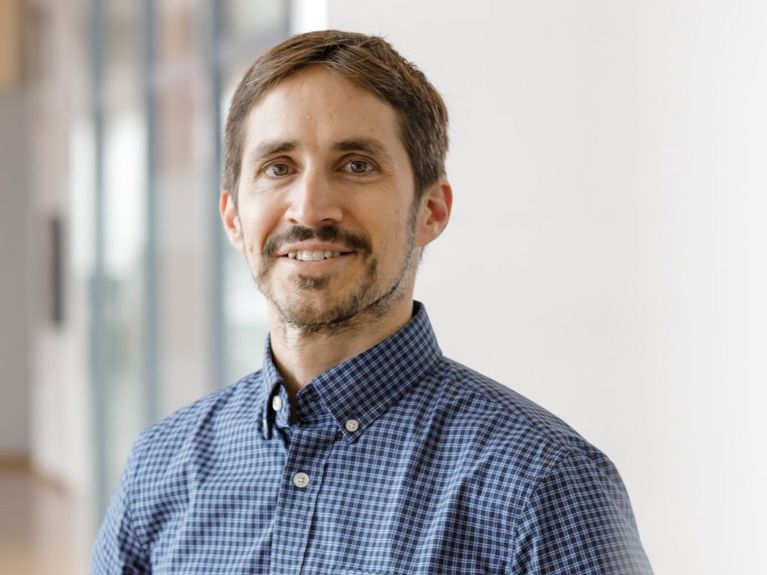Portrait
From Silicon Valley to Jülich

John Paul Strachan. Picture: Forschungszentrum Jülich / R.-U. Limbach
In California, physicist John Paul Strachan investigated how structures of the human brain can be transferred to computers. Now he has moved to Forschungszentrum Jülich to delve even deeper into his major topic.
He was still a teenager at home in the U.S. state of New Mexico when he got his hands on the book "In Search of Schrödinger's Cat," which deals with the world and laws of quantum mechanics. An ambitious read for a teenager, John Paul Strachan admits with a grin in retrospect, and then immediately exclaims in his broad American: "But it captured me! It was so weird, I liked it!"
When he decided to study physics immediately after reading this book, he could not have guessed that this decision would bring him to Jülich many years later. His path led him through some of the best American universities, he even interned in one of the leading laboratories for quantum computing in California and now plans to move to Germany with his wife and three children. A few months ago, he was appointed director of the Peter Gruenberg Institute in Jülich, Germany, where he heads the department that deals with neuromorphic computing nodes. The term can hardly be translated; when John Paul Strachan explains it, he mentions two numbers in succession: People have been working on computers for about 100 years, but evolution has been busy developing brains for many hundreds of millions of years. "I use what has happened in nature as a cheat sheet to design future computer systems," says John Paul Strachan. While some neuroscience researchers want to study the brain until they're able to replicate it, he prefers a different approach: "I don't need to copy all the properties of a brain, but there are lots of ideas in there that can also help us design more powerful computers." He wants to help develop hybrid models in which functionalities of today's computers are enriched with insights from brain research and artificial intelligence.
John Paul Strachan came to his great subject in a roundabout way. "In the beginning, I jumped from topic to topic in my career," he says in retrospect. He earned his bachelor's and master's degrees at the renowned MIT, and went to Stanford for his doctorate. He holds more than 50 patents, and his publications have dealt with tiny nanomagnetic devices as well as ultrafast microscopy. How does that fit together? For Strachan, it's clear: "I look for topics that excite my imagination and with which I can ideally make an impact," he says, and that's why he eventually landed on research into new computers.
Currently, though, one of his biggest challenges is moving his whole family to Europe. It's the first time they've settled here, with all the challenges that entails. The children have to find a school and they all have to learn German as well. At least John Paul Strachan can take one thing with him from California: He loves mountain biking, and the Eifel offers plenty of good trails. "On the bike," he says, "I clear my head for new thoughts."
This is all the more important because quantum computing is one of the most intricate scientific challenges. He himself made a definite commitment to the field after earning his doctorate: He spent 13 years at Hewlett Packard in California, and after a post-doctoral stint there, he kept climbing the ranks. "Actually, I'm an experimenter," he says: He has long been concerned with how devices work and how they can be improved, so he builds prototypes and experiments with them. His team analyzed the semiconductor transistors in common computers and worked their way from alternatives ranging from spintronics to oxide memristors. "And the more time we spent doing that, the more I realized that it's not the devices that are the bottleneck to performance, it's mostly how we move data around within the system." This led him to the study of memory architectures and the entire system. "Now I'm working my way up the entire food chain," he says, "starting with the devices and moving to the data flow and how that relates to the algorithms that are implemented. Rethinking this whole process is what fascinates me."
The appointment to Jülich comes at just the right time for Strachan. "Hewlett Packard Labs is great and there are wonderful researchers working there. But the time horizons have to correspond with product development, of course. The space for basic research is much larger here at Forschungszentrum Jülich," he says. He also says he can use his experience at HP to build bridges between the university, non-university research institutions and large companies. And he gets the opportunity to combine his research with teaching; "this combination has always appealed to me!" So he didn't have to think long about the offer to move to Europe, and then to Jülich, where he can work with materials scientists, computer researchers, neuroscientists and many others. "When I told friends and colleagues in the U.S. about this opportunity, they almost always saw how well it fits with my interests and career path. The decision to go to Germany was almost a no-brainer," says John Paul Strachan. "The funny thing is that here in Germany, everyone always looks incredulous. The question I hear most often is, 'Why are you leaving the U.S. and coming to Germany?'" He shakes his head, then adds, "Must be the German modesty!"
Readers comments